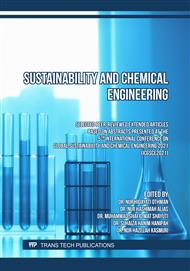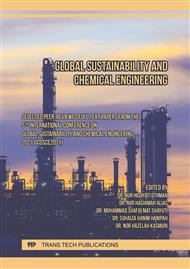[1]
E. T. Igunnu and G. Z. Chen, Produced water treatment technologies,, Int. J. Low-Carbon Technol., vol. 0, no. 1, pp. cts049-v2, 2012,.
Google Scholar
[2]
European Community, Directive 2000/60/EC of the European Parliament and of the Council of 23 October 2000 establishing a framework for Community action in the field of water policy,, Off. J. Eur. Parliam., vol. L327, no. September 1996, p.1–82, 2000,.
DOI: 10.1017/cbo9780511610851.056
Google Scholar
[3]
H. H. Al-Kayiem and J. A. Khan, Evaluation of Alkali/Surfactant/Polymer Flooding on Separation and Stabilization of Water/Oil Emulsion by Statistical Modelling,, Energy & Fuels, p. acs.energyfuels.7b01662, 2017,.
DOI: 10.1021/acs.energyfuels.7b01662
Google Scholar
[4]
T. Zsirai et al., Ceramic membrane filtration of produced water: Impact of membrane module,, Sep. Purif. Technol., vol. 165, p.214–221, 2016,.
DOI: 10.1016/j.seppur.2016.04.001
Google Scholar
[5]
S. S. da Silva, O. Chiavone-Filho, E. L. de Barros Neto, and E. L. Foletto, Oil removal from produced water by conjugation of flotation and photo-Fenton processes,, J. Environ. Manage., vol. 147, p.257–263, 2015,.
DOI: 10.1016/j.jenvman.2014.08.021
Google Scholar
[6]
M. V. Bram, A. A. Hassan, D. S. Hansen, P. Durdevic, S. Pedersen, and Z. Yang, Experimental modeling of a deoiling hydrocyclone system,, 2015 20th Int. Conf. Methods Model. Autom. Robot. MMAR 2015, p.1080–1085, 2015,.
DOI: 10.1109/mmar.2015.7284029
Google Scholar
[7]
T. Husveg, O. Rambeau, T. Drengstig, and T. Bilstad, Performance of a deoiling hydrocyclone during variable flow rates,, Miner. Eng., vol. 20, no. 4, p.368–379, 2007,.
DOI: 10.1016/j.mineng.2006.12.002
Google Scholar
[8]
M. Eftekhardadkhah, S. V. Aanesen, K. Rabe, and G. Øye, Oil Removal from Produced Water during Laboratory- and Pilot-Scale Gas Flotation: The Influence of Interfacial Adsorption and Induction Times,, Energy and Fuels, vol. 29, no. 11, p.7734–7740, 2015,.
DOI: 10.1021/acs.energyfuels.5b02110
Google Scholar
[9]
S. Jr, Laboratory Results of Cleaning Produced Water by Gas Flotation,, Soc. Pet. Eng. J., no. June, p.175–190, 1980,.
Google Scholar
[10]
C. Dalmazzone, C. Noïk, and J.-F. F. Argillier, Impact of Chemical Enhanced Oil Recovery on the Separation of Diluted Heavy Oil Emulsions,, Energy & Fuels, vol. 26, no. 6, p.3462–3469, 2012,.
DOI: 10.1021/ef300083z
Google Scholar
[11]
M. R. Aliff Radzuan, M. A. Abia-Biteo Belope, and R. B. Thorpe, Removal of fine oil droplets from oil-in-water mixtures by dissolved air flotation,, Chem. Eng. Res. Des., vol. 115, p.19–33, 2016,.
DOI: 10.1016/j.cherd.2016.09.013
Google Scholar
[12]
R. Etchepare, H. Oliveira, A. Azevedo, and J. Rubio, Separation of emulsified crude oil in saline water by dissolved air flotation with micro and nanobubbles,, Sep. Purif. Technol., vol. 186, p.326–332, 2017,.
DOI: 10.1016/j.seppur.2017.06.007
Google Scholar
[13]
H. Hosseinzadeh, J. Shayegan, and M. Jalali, Performance enhancement of dissolved air flotation column in removing low concentrations of heavy fuel oil by adding powdered activated carbon,, Desalin. Water Treat., vol. 51, no. 16–18, p.3353–3360, 2013,.
DOI: 10.1080/19443994.2012.749190
Google Scholar
[14]
J. Ran, J. Liu, C. Zhang, D. Wang, and X. Li, Experimental investigation and modeling of flotation column for treatment of oily wastewater,, Int. J. Min. Sci. Technol., vol. 23, no. 5, p.665–668, 2013,.
DOI: 10.1016/j.ijmst.2013.08.008
Google Scholar
[15]
S. Deng, R. Bai, J. P. Chen, G. Yu, Z. Jiang, and F. Zhou, Effects of alkaline/surfactant/polymer on stability of oil droplets in produced water from ASP flooding,, Colloids Surfaces A Physicochem. Eng. Asp., vol. 211, no. 2–3, p.275–284, 2002,.
DOI: 10.1016/s0927-7757(02)00281-9
Google Scholar
[16]
B. Wang et al., The effects of oil displacement agents on the stability of water produced from ASP (alkaline/surfactant/polymer) flooding,, Colloids Surfaces A Physicochem. Eng. Asp., vol. 379, no. 1–3, p.121–126, 2011,.
DOI: 10.1016/j.colsurfa.2010.11.064
Google Scholar
[17]
G. Shutang and G. Qiang, Recent Progress and Evaluation of ASP Flooding for EOR in Daqing Oil Field,, Proc. SPE EOR Conf. Oil Gas West Asia, 2010,.
DOI: 10.2118/127714-ms
Google Scholar
[18]
S. Deng, G. Yu, Z. Jiang, R. Zhang, and Y. P. Ting, Destabilization of oil droplets in produced water from ASP flooding,, Colloids Surfaces A Physicochem. Eng. Asp., vol. 252, no. 2–3, p.113–119, 2005,.
DOI: 10.1016/j.colsurfa.2004.09.033
Google Scholar
[19]
R. Zhang, C. Liang, D. Wu, and S. Deng, Characterization and demulsification of produced liquid from weak base ASP flooding,, Colloids Surfaces A Physicochem. Eng. Asp., vol. 290, no. 1–3, p.164–171, 2006,.
DOI: 10.1016/j.colsurfa.2006.05.023
Google Scholar
[20]
F. Zhang, F. Wang, J. Ouyang, and H. Zhang, The Development and Application of a Demulsifier Used for ASP Flooding–Produced Liquid from the Xing 2 Area of the Daqing Oilfield,, Pet. Sci. Technol., vol. 29, no. 1, p.69–78, 2011,.
DOI: 10.1080/10916460903394177
Google Scholar
[21]
W. K. Qi, Z. C. Yu, Y. Y. Liu, and Y. Y. Li, Removal of emulsion oil from oilfield ASP wastewater by internal circulation flotation and kinetic models,, Chem. Eng. Sci., vol. 91, p.122–129, 2013,.
DOI: 10.1016/j.ces.2013.01.020
Google Scholar
[22]
C. Li and Z. Chen, ASP flooding produced fluid characteristic and treatment process,, p.147–150, (2015).
Google Scholar
[23]
O. D. Chuk, V. Ciribeni, and L. V. Gutierrez, Froth collapse in column flotation: A prevention method using froth density estimation and fuzzy expert systems,, Miner. Eng., 2005,.
DOI: 10.1016/j.mineng.2004.08.013
Google Scholar
[24]
Central Composite Design in a Refinery's Wastewater Treatment by Air Flotation,, Glob. NEST JournalGlobal NEST Int. J., 2018,.
Google Scholar
[25]
J. Behin and S. Bahrami, Modeling an industrial dissolved air flotation tank used for separating oil from wastewater,, Chem. Eng. Process. Process Intensif., 2012,.
DOI: 10.1016/j.cep.2012.05.004
Google Scholar
[26]
C. T. Ta, J. Beckley, and A. Eades, A multiphase CFD model of DAF process,, 2001,.
Google Scholar
[27]
D. M. Leppinen, A kinetic model of dissolved air flotation including the effects of interparticle forces,, J. Water Supply Res. Technol. - AQUA, 2000,.
DOI: 10.2166/aqua.2000.0022
Google Scholar
[28]
K. E. Hani and M. A. Ayoub, Statistical modelling of oil removal from surfactant/polymer flooding produced water by using flotation column,, Indones. J. Chem., 2020,.
DOI: 10.22146/ijc.42820
Google Scholar
[29]
A. Larestani, S. P. Mousavi, F. Hadavimoghaddam, M. Ostadhassan, and A. Hemmati-Sarapardeh, Predicting the surfactant-polymer flooding performance in chemical enhanced oil recovery: Cascade neural network and gradient boosting decision tree,, Alexandria Eng. J., 2022,.
DOI: 10.1016/j.aej.2022.01.023
Google Scholar
[30]
K. E. H. K. Ishak and M. A. Ayoub, Predicting the Efficiency of the Oil Removal from Surfactant and Polymer Produced Water by Using Liquid-Liquid Hydrocyclone: Comparison of Prediction Abilities between Response Surface Methodology and Adaptive Neuro-Fuzzy Inference System,, IEEE Access, 2019,.
DOI: 10.1109/access.2019.2955492
Google Scholar
[31]
K. E. H. Ku Ishak and M. Abdalla Ayoub, Performance of liquid–liquid hydrocyclone (LLHC) for treating produced water from surfactant flooding produced water,, World J. Eng., 2020,.
DOI: 10.1108/wje-01-2019-0003
Google Scholar
[32]
J. Argillier, I. Henaut, C. N. Ifp, R. V. Petrobras, F. R. Leon, and B. Aanesen, Influence of Chemical EOR on Topside Produced Water Management,, SPE Improv. Oil Recover. Symp., p.1–11, 2014,.
DOI: 10.2118/169067-ms
Google Scholar
[33]
F. Richerand, Y. Peymani, and E. S. L. L. C, Improving Flotation Methods to Treat EOR Polymer Rich Produced Water,, no. May, p.20–21, 2015,.
DOI: 10.2118/174535-ms
Google Scholar
[34]
O. Rambeau, M. Jacob, M. Rondon, S. Jouenne, P. Cordelier, and P. C. T. Ep, A tool to tackle the Challenges of the Treatment of the Back Produced Viscosified Water,, Iptc 2014, no. Wang 2011, (2014).
DOI: 10.3997/2214-4609-pdb.395.iptc-17626-ms
Google Scholar
[35]
H. X. Xu, J. T. Liu, L. H. Gao, Y. T. Wang, X. W. Deng, and X. B. Li, Study of Oil Removal Kinetics using Cyclone-Static Microbubble Flotation Column,, Sep. Sci. Technol., vol. 49, no. 8, p.1170–1177, 2014,.
DOI: 10.1080/01496395.2014.881879
Google Scholar




